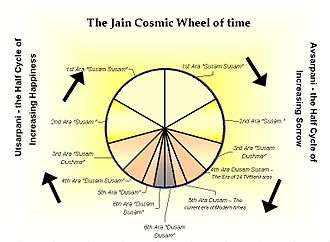Wheel of time
The Wheel of time or wheel of history (also known as Kalachakra) is a concept found in several religious traditions and philosophies, notably religions of Indian origin such as Hinduism, Sikhism, and Buddhism, which regard time as cyclical and consisting of repeating ages. Many other cultures contain belief in a similar concept: notably, the Q'ero Indians in Peru, as well as the Hopi Indians of Arizona.
Hinduism
In Hindu cosmology, Kala (time) is eternal, repeating general events in four types of cycles. The smallest cycle is a Maha Yuga (great age), containing four Yugas (dharmic ages): Satya Yuga, Treta Yuga, Dvapara Yuga and Kali Yuga. A Manvantara (age of Manu) contains 71 Maha Yugas. A Kalpa (day of Brahma) contains 14 Manvantaras and 15 Sandhyas (connecting periods), which lasts for 1,000 Maha Yugas and is followed by a Pralaya (night of partial dissolution) of equal length, where a day and night make one full day. A Maha Kalpa (life of Brahma) lasts for 100 of Brahma's years of 12 months of 30 full days (100 360-day years) or 72,000,000 Maha Yugas, which is followed by a Maha Pralaya (full dissolution) of equal length.[1]
Buddhism
The Wheel of Time or Kalachakra is a Tantric deity that is associated with Tibetan Tantric Buddhism, which encompasses all four main schools of Sakya, Nyingma, Kagyu and Gelug, and is especially important within the lesser-known Jonang tradition.
The Kalachakra tantra prophesies a world within which (religious) conflict is prevalent. A worldwide war will be waged which will see the expansion of the mystical Kingdom of Shambhala led by a messianic king.
Jainism

Within Jainism, time is thought to be a wheel which rotates for infinity without a beginning. This wheel of time holds twelve spokes that each symbolize a different phase in the universe's cosmological history. It is further divided into two equal halves having six eras in them. While in downward motion, the wheel of time falls into what is known as Avasarpiṇī and when in upward motion, enters a state called Utsarpini. During both motions of the wheel, 24 tirthankaras come forth to teach the three jewels or sacred Jain teachings of right faith, right knowledge and right practice, then create a spiritual ford across the ocean of rebirth for humanity.[2][3]
Ancient Rome
The philosopher and emperor Marcus Aurelius saw time as extending forwards to infinity and backwards to infinity, while admitting the possibility (without arguing the case) that "the administration of the universe is organized into a succession of finite periods".[4]
Modern usage
Literature
In an interview included with the audiobook editions of his novels, author Robert Jordan has stated that his bestselling fantasy series The Wheel of Time borrows the titular concept from Hindu mythology.[5]
Television
Several episodes of the American TV series Lost feature a wheel which can be physically turned in order to manipulate space and time. In a series of episodes during the fifth season, the island on which the show takes place begins to skip violently back and forth through time after the wheel is pulled off its axis.

See also
References
- Gupta, Dr. S. V. (2010). Hull, Prof. Robert; Osgood, Jr., Prof. Richard M.; Parisi, Prof. Jurgen; Warlimont, Prof. Hans (eds.). Units of Measurement: Past, Present and Future. International System of Units. Springer Series in Materials Science: 122. Springer. pp. 6-9 (1.2.4 Time Measurements). ISBN 9783642007378.
- Bhattacharyya, Sibajiban (1970). Buddhist Philosophy From 350 to 600 A.D. Motilal Banarsidass. p. 3.
- Paul Dundas (2003). The Jains (2 ed.). Routledge. p. 20.
- Marcus Aurelius. Meditations, book 5, paragraph 13. ISBN 978-0-19-957320-2.
- "Robert Jordan chats about his 'Wheel of Time' series". CNN. CNN. Retrieved 14 June 2017.
1.) Jordan, Robert (1990). The eye of the world. New York: T. Doherty Associates. ISBN 0-312-85009-3.
